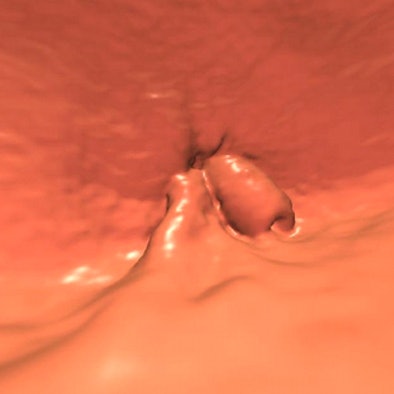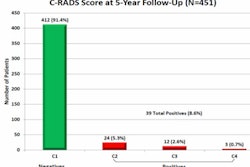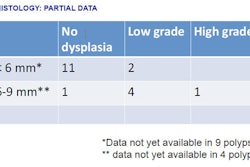
Patients without significant polyps at virtual colonoscopy screening can rest easy for at least five years, according to a study that examined the value of a negative virtual colonoscopy over time. The results, which showed one colon cancer case among more than 1,000 patients, suggest that recommended screening intervals are appropriate.
While much of the research on virtual colonoscopy (also known as CT colonography or CTC) has focused on the sensitivity and specificity of the emerging procedure and its comparison with optical colonoscopy, the critical question of what happens to patients with a negative screening result has been addressed only peripherally.
"Basically, there aren't any data on long-term outcomes in people who undergo virtual colonoscopy and are told that they don't have any polyps," said Dr. Dustin Pooler from the University of Wisconsin in an interview with AuntMinnie.com.
Nevertheless, the question is important because it goes to the heart of what colorectal cancer screening is about -- ruling out disease over the long term, Pooler said.
After all, most screening CTC exams have nothing to report. About 85% of the facility's screening patients are told their CTC is negative because there are no polyps 6 mm or larger, and they should return for another screening in five years.
"We wanted to know the value of that negative screen," he said. Pooler presented the results in March at the Society of Gastrointestinal Radiologists (SGR) Abdominal Radiology Course in Carlsbad, CA.
"Because VC doesn't call polyps that are less than 6 mm in size, there's been a concern that leaving those behind might lead to cancer because they're not being removed and they could progress; and also that CTC may miss some high-risk flat polyps," Pooler said. Although those concerns have not, so far, been substantiated by data, "we were interested in addressing some of those theoretical concerns with actual numbers," he said.
Pooler and his team enrolled 1,209 consecutive patients from the university health system between April 2004 and May 2005. They excluded 30 patients (2.5%) who did not return for follow-up five years later and 129 patients (10.9%) who had a positive result.
The remaining 1,050 patients (483 women, 567 men; mean age, 56.9 ±7.4 years) underwent standard low-dose virtual colonoscopy screening (LightSpeed series CT scanners, GE Healthcare) following cathartic bowel preparation and automated colon insufflation with CO2 (ProtoCO2l, Bracco Diagnostics).
The researchers reviewed the electronic medical record of each patient to assess the incidence of colorectal cancer during the follow-up interval, calculated as the number of days between CTC and the last comprehensive screening exam (virtual or optical colonoscopy, whichever came later).
Final data were available on 1,011 patients with a mean follow-up period of 4.73 ± 1.15 years and a total of 4,785.8 surveillance years, including 590 patients (58.4%) who were followed for more than five years. An additional 368 (36.4%) patients had another CTC or optical colonoscopy exam during the follow-up period.
"The major finding in this study was that out of 1,011 patients that were ultimately included, we found one incident of adenocarcinoma that appeared during that time, which translates to a rate of 0.1%, or a crude incidence of 0.3 cancers per 1,000 patient-years" (95% confidence interval: 0.00529-1.16), according to Pooler. "We consider that significant because the crude incidence of cancer at [optical colonoscopy] has been reported to be 1.7 to 2.4 cancers per 1,000 patient-years, so VC is quite a bit lower, at least on this initial run."
The colorectal cancer was found in a 65-year-old man who presented 35 months after his negative CTC with rectal urgency and a change in stool habits. The diagnostic workup revealed a low rectal adenocarcinoma, stage II (T3, N0). The patient underwent neoadjuvant chemoradiation with complete surgical resection, and he remained disease-free as of January 2011.
"We looked at the VC that was performed on him, and there really wasn't a whole lot to see -- a questionable lesion in a difficult area sort of near where the rectal catheter is," Pooler said. "We looked at it on a few different views."
 |
| 65-year-old patient developed a low rectal adenocarcinoma, stage II (T3, N0), three years after a negative screening VC; original lesion seen in endoluminal view above. Image courtesy of Dr. Dustin Pooler and Dr. Perry Pickhardt. |
There were some limitations to the study, such as 14 patients (3.8%) who underwent an interval CTC or optical colonoscopy and had clinically significant findings, including 11 advanced adenomas (defined as ≥ 10 mm in diameter, harboring high-grade dysplasia, or ≥ 25% villous histology). There were also six polyps of unknown histology 6 to 9 mm in size that remain under CTC surveillance, Pooler said.
In addition, a small number of patients (3.7%) were lost to follow-up. Finally, there is a theoretical possibility of clinically silent tumors, although none were identified in the 368 patients (36.4%) who had interval luminal examinations.
"We didn't find any cancers in those patients, but this was a retrospective study so obviously something prospective would further support these results," Pooler said.
Outside the colon, three patients presented symptomatically between one and five years after CTC and were found to have one appendiceal goblet cell carcinoid tumor, one appendiceal mucinous tumor, and an ileocecal carcinoid with liver metastasis. All underwent surgical resection and were alive as of May 2011.
The take-home message from the study is that incident colorectal adenocarcinoma in the five years following a negative VC screening is very rare and compares favorably to optical colonoscopy, Pooler said.
As for diminutive polyps detected at CTC but not removed, "there appears to be very little risk for not reporting them and not harvesting them," while there are risks inherent in removing them, Pooler said.
"Every time a colonoscopist does a biopsy and removes a diminutive polyp, there is a small risk of colonic perforation and complications," he said. As for the present strategy of asking patients with negative CTC results to return for another screening in five years, "that seems like an appropriate strategy based on the data," he said.
Of course, CTC may be protective even longer, Pooler added. At the University of Wisconsin Health Center, patients are given the option of waiting 10 years after their second negative virtual colonoscopy result.



















